| Revision as of 06:56, 14 January 2018 view sourceNoychoH (talk | contribs)Extended confirmed users2,361 edits →Various claims: link← Previous edit | Latest revision as of 21:44, 29 December 2024 view source GOLDIEM J (talk | contribs)Extended confirmed users4,957 editsNo edit summaryTags: Mobile edit Mobile web edit Advanced mobile edit | ||
| (720 intermediate revisions by more than 100 users not shown) | |||
| Line 1: | Line 1: | ||
| {{pp|small=yes}} | |||
| {{Short description|Unclaimed land between Egypt and Sudan}} | |||
| {{Infobox settlement | {{Infobox settlement | ||
| <!--See the Table at Infobox Settlement for all fields and descriptions of usage--> | <!--See the Table at Infobox Settlement for all fields and descriptions of usage--> | ||
| <!-- Basic info ----------------> | <!-- Basic info ---------------->| name = {{lang|arz-Latn|Bir Ṭawil|italic=no}} | ||
| | |
| other_name = | ||
| | native_name = {{lang|arz|بير طويل}} | |||
| |other_name = | |||
| | |
| nickname = | ||
| | settlement_type = ] | |||
| |nickname = | |||
| | motto = <!-- images and maps -----------> | |||
| |settlement_type = | |||
| | image_skyline = File:Topographic Map of Bir Tawil.png | |||
| |motto = | |||
| | imagesize = 250px | |||
| <!-- images and maps -----------> | |||
| | image_caption = ] of {{lang|arz-Latn|Bir Ṭawil|italic=no}} (outlined in red) | |||
| |image_skyline = | |||
| | |
| image_map = | ||
| | |
| mapsize = | ||
| | |
| map_caption = | ||
| | pushpin_map = Egypt#Sudan#Africa<!-- the name of a location map as per http://en.wikipedia.org/Template:Location_map --> | |||
| |mapsize = | |||
| | pushpin_label_position = bottom | |||
| |map_caption = | |||
| | pushpin_mapsize = 300 | |||
| |pushpin_map = Egypt#Sudan<!-- the name of a location map as per http://en.wikipedia.org/Template:Location_map --> | |||
| | pushpin_map_caption = Location between Egypt and Sudan | |||
| |pushpin_label_position = bottom | |||
| | pushpin_map_alt = Neither Egypt nor Sudan claims {{lang|arz-Latn|Bir Tawil|italic=no}}, which is located between the two countries | |||
| |pushpin_mapsize = 300 | |||
| <!-- Location ------------------>| subdivision_type = ] | |||
| |pushpin_map_caption = Location between Egypt and Sudan | |||
| | subdivision_name = ] | |||
| |pushpin_map_alt = Neither Egypt nor Sudan claim Bir Tawil, which is located between the two countries. | |||
| <!-- |
<!-- Area --------------------->| area_magnitude = | ||
| | |
| unit_pref = metric | ||
| | area_footnotes = | |||
| |subdivision_name = ] | |||
| | area_total_km2 = 2060 | |||
| |subdivision_type1 = | |||
| | area_land_km2 = <!--See table @ Template:Infobox Settlement for details on automatic unit conversion--> | |||
| |subdivision_name1 = | |||
| | area_water_sq_mi = 0 | |||
| |subdivision_type2 = | |||
| <!-- Population ----------------------->| population_as_of = | |||
| |subdivision_name2 = | |||
| | population_footnotes = | |||
| |subdivision_type3 = | |||
| | population_note = Transient populations only<ref>{{Cite journal |last=Karalekas |first=Dean |title=Navigating Terra Nullius: The Ababda and the Case for Indigenous Land Rights in Bir Tawil |journal=Global Journal of Economics and Finance |year=2020 |volume=4 |issue=2 |pages=41–49 |url=http://www.gjefnet.com/images/Vol4No2/4.pdf |archive-url=https://web.archive.org/web/20210120194441/http://www.gjefnet.com/images/Vol4No2/4.pdf |archive-date=20 January 2021}}</ref> | |||
| |subdivision_name3 = | |||
| | population_total = 0 | |||
| <!-- Area ---------------------> | |||
| | population_density_sq_mi = | |||
| |area_magnitude = | |||
| | population_metro = | |||
| |unit_pref = metric | |||
| | population_density_metro_km2 = | |||
| |area_footnotes = | |||
| | population_density_metro_sq_mi = | |||
| |area_total_km2 = 2060 | |||
| | population_blank1_title = Ethnicities | |||
| |area_land_km2 = <!--See table @ Template:Infobox Settlement for details on automatic unit conversion--> | |||
| | population_blank1 = | |||
| <!-- Population -----------------------> | |||
| | population_density_blank1_km2 = | |||
| |population_as_of = 2014 | |||
| | population_density_blank1_sq_mi = <!-- General information ---------------> | |||
| |population_footnotes = | |||
| | |
| timezone = | ||
| | |
| utc_offset = | ||
| | |
| timezone_DST = | ||
| | utc_offset_DST = | |||
| |population_metro = | |||
| | coordinates = {{Coord|21|52|9|N|33|44|52|E|type:landmark|display=inline,title}} | |||
| |population_density_metro_km2 = | |||
| | elevation_footnotes = <!--for references: use <ref> </ref> tags--> | |||
| |population_density_metro_sq_mi = | |||
| | |
| elevation_m = | ||
| | elevation_ft = <!-- Area/postal codes & others --------> | |||
| |population_blank1 = | |||
| | footnotes = | |||
| |population_density_blank1_km2 = | |||
| | image_flag = | |||
| |population_density_blank1_sq_mi = | |||
| | leader_title = | |||
| <!-- General information ---------------> | |||
| | |
| leader_name = | ||
| | government_type = | |||
| |utc_offset = | |||
| }} | |||
| |timezone_DST = | |||
| {{lang|arz-Latn|'''Bir Tawil'''|italic=no}} ({{langx|arz|بير طويل|translit=Bīr Ṭawīl|lit=tall water well}}, {{IPA|arz|biːɾ tˤɑˈwiːl|}}) is a {{convert|2060|km2|mi2|sigfig=4|abbr=on}} area of land along the ] between ] and ], which is uninhabited and claimed by neither country. When spoken of in association with the neighbouring ], it is sometimes referred to as the '''{{lang|arz-Latn|Bir Tawil|italic=no}} Triangle''', despite the area's ] shape; the two regions border at a ]. | |||
| |utc_offset_DST = | |||
| |coordinates = {{coord|21|52|9|N|33|44|52|E|type:landmark|display=inline,title}} | |||
| |elevation_footnotes = <!--for references: use <ref> </ref> tags--> | |||
| |elevation_m = | |||
| |elevation_ft = | |||
| <!-- Area/postal codes & others --------> | |||
| |footnotes = | |||
| |image_flag = |leader_title = |leader_name = |government_type = }} | |||
| ] topographic map. The Bir Tawil area is at the top.]] | |||
| ] | |||
| '''Bir Tawil''' or '''Bi'r Tawīl''' ({{Lang-arz|بير طويل}} ''{{transl|arz|Bīr Ṭawīl}}'' {{IPA-arz|biːɾ tˤɑˈwiːl|}} or {{lang|ar|بئر طويل}} ''{{transl|ar|Bi’r Ṭawīl}}'', meaning "tall ]") is a {{convert|2060|km2|mi2|abbr=on}} area along the border between ] and ], which is uninhabited and claimed by neither country. When spoken of in association with the neighbouring ], it is sometimes referred to as the '''Bir Tawil Triangle''', despite the area's ] shape; the two "triangles" border at a ]. | |||
| Its |
Its unclaimed status results from a discrepancy between the straight political boundary between Egypt and Sudan established in 1899, and the irregular administrative boundary established in 1902. Egypt asserts the political boundary, and Sudan asserts the administrative boundary, with the result that the {{lang|ar-Latn|Halaib|italic=no}} Triangle is claimed by both and {{lang|arz-Latn|Bir Tawil|italic=no}} by neither. In 2014, author Alastair Bonnett described {{lang|arz-Latn|Bir Tawil|italic=no}} as the only place on Earth that was ] but was ].<ref name="Bonnett2014">{{cite book|last=Bonnett |first=Alastair |title=Unruly Places: Lost Spaces, Secret Cities and Other Inscrutable Geographies |chapter=Bir Tawil |chapter-url=https://books.google.com/books?id=9eNJAQAAQBAJ&pg=PA73 |date=2014 |publisher=Houghton Mifflin Harcourt |isbn=978-0-544-10160-9 |page=73 |oclc=890509603 |lccn=2013050983 |quote=the only place on the planet that is both habitable and unclaimed.}}</ref> | ||
| ==History== | ==History== | ||
| In 1899, when the ] held authority in the area, the ] Agreement for Sudan set the border between the territories at the ]. However, in 1902 the UK drew a separate "administrative boundary", intended to reflect the actual use of the land by the tribes in the region. Bir Tawil was grazing land used by the ] tribe based near ], and thus was placed under Egyptian administration from ]. Similarly, the Hala'ib Triangle to the northeast was placed under the British governor of Sudan, because its inhabitants were culturally closer to ]. | |||
| On 19 January 1899, an agreement between the ] and Egypt relating to the administration of Sudan defined "Soudan" as the "territories south of the ]".<ref name=":0">{{Cite web|url=http://www.law.fsu.edu:80/library/collectio/limitsinseas/ibs018.pdf|title=International Boundary Study: Sudan – Egypt (United Arab Republic) Boundary|date=27 July 1962|website=law.fsu.edu|publisher=Bureau of Intelligence and Research|pages=2, 3|archive-url=https://web.archive.org/web/20140113231654/http://www.law.fsu.edu/library/collection/limitsinseas/ibs018.pdf|archive-date=13 January 2014|url-status=dead|access-date=2019-05-28}}</ref> It contained a provision that would give Egypt control of the ] port of {{lang|ar-Latn|]|italic=no}}, but an amendment on 10 July 1899 gave Suakin to Sudan instead.<ref name=":0"/> | |||
| Egypt claims the original border from 1899, the 22nd parallel, which would place the Hala'ib Triangle within Egypt and the Bir Tawil area within Sudan. Sudan however claims the administrative border of 1902, which would put Hala'ib within Sudan, and Bir Tawil within Egypt. As a result, both states claim the ] and neither claims the much less valuable Bir Tawil area, which is only a tenth the size, and has no permanent settlements or access to the sea. There is no basis in international law for either Sudan or Egypt to claim both territories, and neither nation is willing to cede Hala'ib. With no third state claiming the neglected area, Bir Tawil is one of the few land areas of the world ]. Egypt arguably still administers the territory, but it is not marked as Egyptian on government maps.<ref>{{cite web|url=http://www.mcit.gov.eg/images/maps/Intl_Boundaries_map1.jpg |title=Official version of map of Egypt |date= |accessdate=2017-03-05}}</ref><ref>{{cite book|title=CIA World Factbook 2010|url=https://books.google.com/books?id=pqanFyF6nI0C&pg=PA209|year=2010|publisher=CIA|chapter=Egypt}}</ref> | |||
| {{clear|left}} | |||
| ] | |||
| On 4 November 1902, the UK drew a separate "administrative boundary", intended to reflect the actual use of the land by the tribes in the region.<ref name=":0"/> {{lang|arz-Latn|Bir Tawil|italic=no}} was grazing land used by the {{lang|ar-Latn|]|italic=no}} tribe based near {{lang|ar-Latn|]|italic=no}}, and thus was placed under Egyptian administration from ]. Similarly, the {{lang|ar-Latn|Hala'ib|italic=no}} Triangle to the northeast was placed under the British governor of Sudan, because its inhabitants were culturally closer to ]. | |||
| Egypt claims the original border from 1899, the 22nd parallel, which would place the {{lang|ar-Latn|Hala'ib|italic=no}} Triangle within Egypt and the {{lang|arz-Latn|Bir Tawil|italic=no}} area within Sudan. Sudan, however, claims the administrative border of 1902, which would put {{lang|ar-Latn|Hala'ib|italic=no}} within Sudan, and {{lang|arz-Latn|Bir Tawil|italic=no}} within Egypt. As a result, both states claim {{lang|ar-Latn|Hala'ib|italic=no}} and neither claims the much less valuable {{lang|arz-Latn|Bir Tawil|italic=no}} area, which is only a tenth the size, and has no permanent settlements or access to the sea. There is no basis in international law for either Sudan or Egypt to claim both territories, and neither nation is willing to cede {{lang|ar-Latn|Hala'ib|italic=no}}. With no recognized third state claiming the neglected area, {{lang|arz-Latn|Bir Tawil|italic=no}} is one of the few land areas of the world not claimed by any recognised state.<ref>{{cite web |url=http://www.mcit.gov.eg/images/maps/Intl_Boundaries_map1.jpg |title=Official version of map of Egypt |access-date=2017-03-05 |archive-url=https://web.archive.org/web/20130526181255/http://www.mcit.gov.eg/images/maps/Intl_Boundaries_map1.jpg |archive-date=2013-05-26 |url-status=live}}</ref><ref>{{cite book|title=CIA World Factbook |chapter-url=https://books.google.com/books?id=pqanFyF6nI0C&pg=PA209|year=2010|publisher=CIA|chapter=Egypt|isbn = 978-1602397279}}</ref> | |||
| ==Geography== | ==Geography== | ||
| ]]] | |||
| Bir Tawil is {{convert|2060|km²|0|abbr=on}} in size. The length of its northern and southern borders are {{convert|95|km|mi}} and {{convert|46|km|mi}} respectively; the length of its eastern and western borders are {{convert|26|km|mi}} and {{convert|49|km|mi}} respectively. | |||
| {{lang|arz-Latn|Bir Tawil|italic=no}} is {{convert|2060|km2|1|abbr=on}} in size. The length of its northern and southern borders are {{convert|95|km|mi}} and {{convert|46|km|mi}} respectively; the length of its eastern and western borders are {{convert|26|km|mi}} and {{convert|49|km|mi}} respectively. In the north of the area is the mountain {{lang|ar-Latn|Jabal Ṭawil|italic=no}} ({{lang|ar|جبل طويل}}), with a height of {{convert|459|m|ft}}. In the east is {{lang|ar-Latn|]|italic=no}}, with a height of {{convert|662|m|ft}}, marking the territory's highest point. In the south is the {{lang|ar-Latn|] Ṭawil|italic=no}} ({{lang|ar|وادي طويل}}), also called {{lang|ar-Latn|Khawr Abū Bard}}. There is no surface water in Bir Tawil.<ref>{{Cite news |last=Shenker |first=Jack |date=2016-03-03 |title=Welcome to the land that no country wants |language=en-GB |work=The Guardian |url=https://www.theguardian.com/world/2016/mar/03/welcome-to-the-land-that-no-country-wants-bir-tawil |access-date=2023-12-11 |issn=0261-3077}}</ref> | |||
| ==Climate== | |||
| In the north of the area is the mountain Jabal Tawil ({{lang|ar|جبل طويل}}), located at {{Coord|21|57|56|N|33|48|05|E|name=Jabal Tawil}}, with a height of {{convert|459|m|ft}}. In the east is ], with a height of {{convert|662|m|ft}}. | |||
| {{lang|arz-Latn|Bir Tawil|italic=no}}'s climate is, according to the ], a ] (Bwh). For approximately three-quarters of the year the temperature can exceed {{convert|40|C}}, and in the three hottest months (June–August) it can be as high as {{convert|45|C|F}}. During the winters (December and January being its mildest months), {{lang|arz-Latn|Bir Tawil|italic=no}} can have lower temperatures, with {{convert|26|C}} as its usual temperature peak. | |||
| In the south is the ] Tawil ({{lang|ar|وادي طويل}}), also called ''Khawr Abū Bard'', located at {{Coord|21|49|25|N|33|43|42|E|name=Wadi Tawil}}. | |||
| Because the territory is far from the ocean (being at least {{cvt|200|km|disp=or}} away from the Red Sea), the ] throughout the region is large, about {{convert|20|°C-change|°F-change}} year-round.<ref></ref> | |||
| ==Various claims== | |||
| <!-- This has been discussed on the Talk Page. PLEASE only add any further claims to Bir Tawil AS A REFERENCE at the end of this sentence, unless it has actually solved Egypt and Sudan's border dispute. -->Due to its status as '']'' unclaimed territory, multiple individuals and organizations have attempted to ] Bir Tawil. However, none has been taken seriously by the international community, and due to the remoteness and hostile climate of the region, the vast majority of these claims have been by declarations posted online from other locations. | |||
| {{Weather box|location=Bir Tawil|metric first=yes|single line=yes|Jan high C=26|Feb high C=28|Mar high C=32|Apr high C=37|May high C=40|Jun high C=42|Jul high C=42|Aug high C=42|Sep high C=41|Oct high C=38|Nov high C=32|Dec high C=27|Jan low C=7|Feb low C=8|Mar low C=11|Apr low C=16|May low C=20|Jun low C=22|Jul low C=24|Aug low C=24|Sep low C=22|Oct low C=19|Nov low C=13|Dec low C=9|source 1=''MeteoBlue.com''<ref>{{cite web | |||
| One claimant, Jack Shenker, visited Bir Tawil in 2011 and planted a multicolored flag designed around a yellow desert fox. Schenker visited the territory while he was conducting research on Bir Tawil for an article that he was writing for '']''.<ref name="shenker030316">{{cite news| last1=Shenker |first1=Jack |title=Welcome to the land that no country wants |url=https://www.theguardian.com/world/2016/mar/03/welcome-to-the-land-that-no-country-wants-bir-tawil |accessdate=3 March 2016 |newspaper=] |date=3 March 2016}}</ref> Jeremiah Heaton, an American citizen who traveled to Bir Tawil in 2014, claimed the region as a new sovereign state, the ].<ref name="telegraph_heaton">{{cite news |last=Ensor |first=Josie |date=14 July 2014 |title=US father takes unclaimed African kingdom so his daughter can be a princess |url=http://www.telegraph.co.uk/news/worldnews/northamerica/usa/10965298/US-father-takes-unclaimed-African-kingdom-so-his-daughter-can-be-a-princess.html |newspaper=] |location=London |accessdate=27 July 2014 }}</ref> No claims have been recognized, officially or otherwise, by any government or international organization.<ref name="shenker030316" /><ref name="Guardian_Heaton">{{cite news |last=Liston |first=Enjoli |date=16 July 2014 |title=American plans to use his piece of Africa for advancement of science |url=https://www.theguardian.com/world/2014/jul/16/american-claim-africa-science-jeremiah-heaton-egypt-sudan |newspaper=] |location=London |accessdate=16 Oct 2017}}</ref> | |||
| |url=https://www.meteoblue.com/en/weather/historyclimate/climatemodelled/21.815N33.856E393_Africa%2FCairo | |||
| |title=Weather for Bir Tawil | |||
| |access-date=6 November 2019 | |||
| |publisher=MeteoBlue.com | |||
| }}</ref>}} | |||
| ==Claims== | |||
| <!-- This has been discussed on the Talk Page. PLEASE only add any further claims to Bir Tawil AS A REFERENCE at the end of this sentence, unless it has actually solved Egypt and Sudan's border dispute. --> | |||
| {{see also|Attempts to claim Bir Tawil as a nation state}} | |||
| Due to its status as ''{{Lang|la|]}}'' unclaimed territory, a number of individuals and organizations have attempted to ] {{lang|arz-Latn|Bir Tawil|italic=no}} as a ]; because of the remoteness and hostile climate of the region, the vast majority of these claims have been by declarations posted on the internet from other locations. None of these claims, or any others, have been recognized, officially or otherwise, by any government or international organization.<ref name="shenker030316">{{cite news| last1=Shenker |first1=Jack |title=Welcome to the land that no country wants |url=https://www.theguardian.com/world/2016/mar/03/welcome-to-the-land-that-no-country-wants-bir-tawil |access-date=3 March 2016 |newspaper=] |date=3 March 2016}}</ref><ref>{{Cite web |last=Ma |first=Alexandra |title=This man is the latest in a series of travellers to declare ownership of a bizarre no man's land in north Africa |url=https://www.businessinsider.com/bir-tawil-suyash-dixit-declares-ownership-of-land-in-north-africa-2017-11 |date=15 November 2017 |access-date=7 August 2022 |website=Business Insider |language=en-US}}</ref>{{clear left}} | |||
| ==Population== | |||
| Bir Tawil has no settled population, but members of the ] and ] tribes pass through the region,<ref name="shenker030316">{{cite news| last1=Shenker |first1=Jack |title=Welcome to the land that no country wants |url=https://www.theguardian.com/world/2016/mar/03/welcome-to-the-land-that-no-country-wants-bir-tawil |access-date=3 March 2016 |newspaper=] |date=3 March 2016}}</ref> and unregulated mining camps have been established throughout the territory in search of gold deposits.<ref>{{cite news| author=Batya |title=Bir Tawil – Tracking Kalashnikovs in No Man's Land |url=https://reaperfeed.com/bir-tawil-tracking-kalashnikovs-in-no-mans-land/ |access-date=19 February 2023 |newspaper=Reaper Feed |date=18 July 2020}}</ref><ref>{{cite news| last1=O'Connor |first1=Robert |title=The Battle for the Last Unclaimed Land on Earth |url=https://www.vice.com/en/article/pkpe5m/the-battle-for-the-last-unclaimed-land-on-earth |access-date=19 February 2023 |newspaper=] |date=27 October 2021}}</ref> ] operated two tours to the territory in 2019 and 2024, and claimed the existence of permanent settlements related to the unregulated mining camps.<ref>{{Cite web |date=2019-04-11 |title=Bir Tawil: The Strange Tale of Unclaimed Land — 2024 Travel Update |url=https://www.youngpioneertours.com/strange-tale-bir-tawil/ |access-date=2024-07-24 |website=Young Pioneer Tours |language=en}}</ref> | |||
| == Literature == | |||
| * Dean Karalekas (2020). ''The Men in No Man’s Land: A Journey Into Bir Tawil''. pp. 120 pages. {{ISBN|979-8666413401}}. | |||
| ==See also== | ==See also== | ||
| * ], an adjoining area, claimed by both Egypt and Sudan | |||
| * ] | |||
| * ] | * ] | ||
| * ], an area in Antarctica that is also unclaimed | |||
| * ], another border dispute with unclaimed territories. | |||
| * ] | |||
| * '']'' | |||
| ==References== | ==References== | ||
| {{reflist}} | {{reflist}} | ||
| {{refimprove|date=December 2013}} | |||
| ==External links== | ==External links== | ||
| {{commons category|Bir Tawil}} | {{commons category|Bir Tawil}} | ||
| {{Wikivoyage}} | {{Wikivoyage}} | ||
| * | * | ||
| * | * | ||
| * '''' documentary | |||
| {{Countries and territories of North Africa}} | {{Countries and territories of North Africa}} | ||
| {{Micronations}} | |||
| ] | |||
| ] | ] | ||
| ] | ] | ||
| ] | ] | ||
| ] | |||
Latest revision as of 21:44, 29 December 2024
Unclaimed land between Egypt and Sudan Unclaimed land in None
| Bir Ṭawil بير طويل | |
|---|---|
| Unclaimed land | |
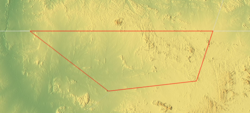 Topographic map of Bir Ṭawil (outlined in red) Topographic map of Bir Ṭawil (outlined in red) | |
 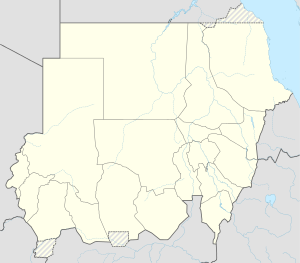 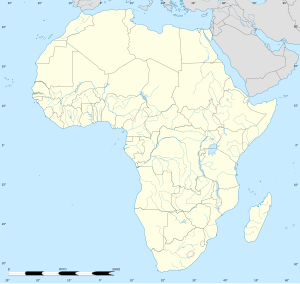 | |
| Coordinates: 21°52′9″N 33°44′52″E / 21.86917°N 33.74778°E / 21.86917; 33.74778 | |
| Country | None |
| Area | |
| • Total | 2,060 km (800 sq mi) |
| • Water | 0 km (0 sq mi) |
| Population | |
| • Total | 0 |
| Transient populations only | |
Bir Tawil (Egyptian Arabic: بير طويل, romanized: Bīr Ṭawīl, lit. 'tall water well', [biːɾ tˤɑˈwiːl]) is a 2,060 km (795.4 sq mi) area of land along the border between Egypt and Sudan, which is uninhabited and claimed by neither country. When spoken of in association with the neighbouring Halaib Triangle, it is sometimes referred to as the Bir Tawil Triangle, despite the area's quadrilateral shape; the two regions border at a quadripoint.
Its unclaimed status results from a discrepancy between the straight political boundary between Egypt and Sudan established in 1899, and the irregular administrative boundary established in 1902. Egypt asserts the political boundary, and Sudan asserts the administrative boundary, with the result that the Halaib Triangle is claimed by both and Bir Tawil by neither. In 2014, author Alastair Bonnett described Bir Tawil as the only place on Earth that was habitable but was not claimed by any recognised government.
History
On 19 January 1899, an agreement between the United Kingdom and Egypt relating to the administration of Sudan defined "Soudan" as the "territories south of the 22nd parallel of latitude". It contained a provision that would give Egypt control of the Red Sea port of Suakin, but an amendment on 10 July 1899 gave Suakin to Sudan instead.
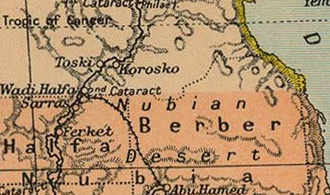
On 4 November 1902, the UK drew a separate "administrative boundary", intended to reflect the actual use of the land by the tribes in the region. Bir Tawil was grazing land used by the Ababda tribe based near Aswan, and thus was placed under Egyptian administration from Cairo. Similarly, the Hala'ib Triangle to the northeast was placed under the British governor of Sudan, because its inhabitants were culturally closer to Khartoum.
Egypt claims the original border from 1899, the 22nd parallel, which would place the Hala'ib Triangle within Egypt and the Bir Tawil area within Sudan. Sudan, however, claims the administrative border of 1902, which would put Hala'ib within Sudan, and Bir Tawil within Egypt. As a result, both states claim Hala'ib and neither claims the much less valuable Bir Tawil area, which is only a tenth the size, and has no permanent settlements or access to the sea. There is no basis in international law for either Sudan or Egypt to claim both territories, and neither nation is willing to cede Hala'ib. With no recognized third state claiming the neglected area, Bir Tawil is one of the few land areas of the world not claimed by any recognised state.
Geography
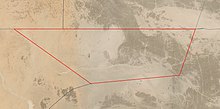
Bir Tawil is 2,060 km (795.4 sq mi) in size. The length of its northern and southern borders are 95 kilometres (59 mi) and 46 kilometres (29 mi) respectively; the length of its eastern and western borders are 26 kilometres (16 mi) and 49 kilometres (30 mi) respectively. In the north of the area is the mountain Jabal Ṭawil (جبل طويل), with a height of 459 metres (1,506 ft). In the east is Gabal Hagar El Zarqa, with a height of 662 metres (2,172 ft), marking the territory's highest point. In the south is the Wadi Ṭawil (وادي طويل), also called Khawr Abū Bard. There is no surface water in Bir Tawil.
Climate
Bir Tawil's climate is, according to the Köppen climate classification, a hot desert climate (Bwh). For approximately three-quarters of the year the temperature can exceed 40 °C (104 °F), and in the three hottest months (June–August) it can be as high as 45 °C (113 °F). During the winters (December and January being its mildest months), Bir Tawil can have lower temperatures, with 26 °C (79 °F) as its usual temperature peak.
Because the territory is far from the ocean (being at least 200 km or 120 mi away from the Red Sea), the diurnal temperature range throughout the region is large, about 20 °C (36 °F) year-round.
| Climate data for Bir Tawil | |||||||||||||
|---|---|---|---|---|---|---|---|---|---|---|---|---|---|
| Month | Jan | Feb | Mar | Apr | May | Jun | Jul | Aug | Sep | Oct | Nov | Dec | Year |
| Mean daily maximum °C (°F) | 26 (79) |
28 (82) |
32 (90) |
37 (99) |
40 (104) |
42 (108) |
42 (108) |
42 (108) |
41 (106) |
38 (100) |
32 (90) |
27 (81) |
36 (96) |
| Mean daily minimum °C (°F) | 7 (45) |
8 (46) |
11 (52) |
16 (61) |
20 (68) |
22 (72) |
24 (75) |
24 (75) |
22 (72) |
19 (66) |
13 (55) |
9 (48) |
16 (61) |
| Source: MeteoBlue.com | |||||||||||||
Claims
See also: Attempts to claim Bir Tawil as a nation stateDue to its status as de jure unclaimed territory, a number of individuals and organizations have attempted to claim Bir Tawil as a micronation; because of the remoteness and hostile climate of the region, the vast majority of these claims have been by declarations posted on the internet from other locations. None of these claims, or any others, have been recognized, officially or otherwise, by any government or international organization.
Population
Bir Tawil has no settled population, but members of the Ababda and Bishari tribes pass through the region, and unregulated mining camps have been established throughout the territory in search of gold deposits. Young Pioneer Tours operated two tours to the territory in 2019 and 2024, and claimed the existence of permanent settlements related to the unregulated mining camps.
Literature
- Dean Karalekas (2020). The Men in No Man’s Land: A Journey Into Bir Tawil. pp. 120 pages. ISBN 979-8666413401.
See also
- Egypt–Sudan relations
- Marie Byrd Land, an area in Antarctica that is also unclaimed
- Croatia–Serbia border dispute, another border dispute with unclaimed territories.
- Wadi Halfa Salient
- Terra nullius
References
- Karalekas, Dean (2020). "Navigating Terra Nullius: The Ababda and the Case for Indigenous Land Rights in Bir Tawil" (PDF). Global Journal of Economics and Finance. 4 (2): 41–49. Archived from the original (PDF) on 20 January 2021.
- Bonnett, Alastair (2014). "Bir Tawil". Unruly Places: Lost Spaces, Secret Cities and Other Inscrutable Geographies. Houghton Mifflin Harcourt. p. 73. ISBN 978-0-544-10160-9. LCCN 2013050983. OCLC 890509603.
the only place on the planet that is both habitable and unclaimed.
- ^ "International Boundary Study: Sudan – Egypt (United Arab Republic) Boundary" (PDF). law.fsu.edu. Bureau of Intelligence and Research. 27 July 1962. pp. 2, 3. Archived from the original (PDF) on 13 January 2014. Retrieved 2019-05-28.
- "Official version of map of Egypt". Archived from the original on 2013-05-26. Retrieved 2017-03-05.
- "Egypt". CIA World Factbook. CIA. 2010. ISBN 978-1602397279.
- Shenker, Jack (2016-03-03). "Welcome to the land that no country wants". The Guardian. ISSN 0261-3077. Retrieved 2023-12-11.
- "Climate: Bir Tawil
- "Weather for Bir Tawil". MeteoBlue.com. Retrieved 6 November 2019.
- ^ Shenker, Jack (3 March 2016). "Welcome to the land that no country wants". The Guardian. Retrieved 3 March 2016.
- Ma, Alexandra (15 November 2017). "This man is the latest in a series of travellers to declare ownership of a bizarre no man's land in north Africa". Business Insider. Retrieved 7 August 2022.
- Batya (18 July 2020). "Bir Tawil – Tracking Kalashnikovs in No Man's Land". Reaper Feed. Retrieved 19 February 2023.
- O'Connor, Robert (27 October 2021). "The Battle for the Last Unclaimed Land on Earth". VICE News. Retrieved 19 February 2023.
- "Bir Tawil: The Strange Tale of Unclaimed Land — 2024 Travel Update". Young Pioneer Tours. 2019-04-11. Retrieved 2024-07-24.
External links
- Google Sightseeing – Bir Tawil Triangle
- International Boundary Study
- The King of North Sudan documentary
| Countries and territories of North Africa | |||||||||||||||||
|---|---|---|---|---|---|---|---|---|---|---|---|---|---|---|---|---|---|
| Sovereign states | |||||||||||||||||
| Partially recognized state | |||||||||||||||||
| Territories |
| ||||||||||||||||
| Entirely claimed by both Morocco and the SADR. Spanish exclaves claimed by Morocco. Portuguese archipelago claimed by Spain. Disputed between Egypt and the Sudan. Unclaimed territory located between Egypt and the Sudan. Disputed between South Sudan and the Sudan. Part of Chad, formerly claimed by Libya. Disputed between Morocco and Spain | |||||||||||||||||